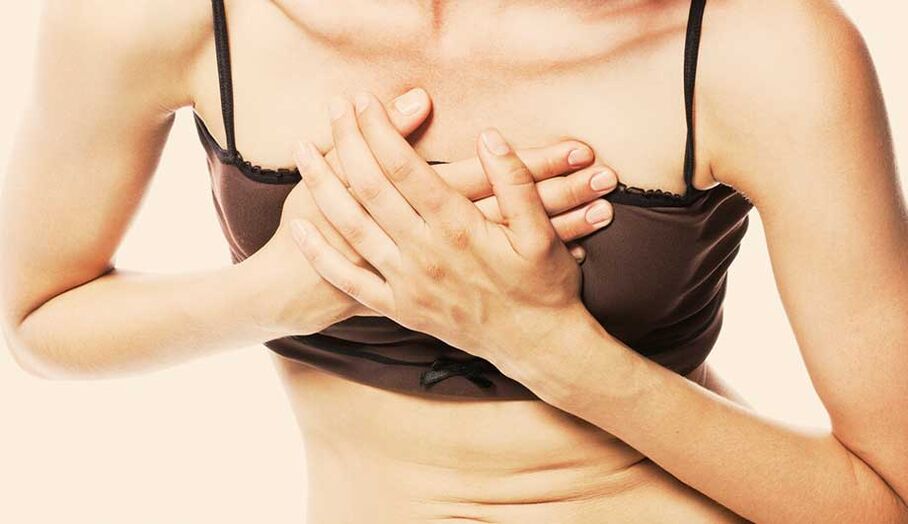Osteochondrosis is a very dangerous disease. It occurs imperceptibly and, from slightly uncomfortable sensations, turns into serious disorders of the spine, which sometimes leads to disability.

Therapists, neurologists, orthopedists, vertebrologists and other specialists are involved in the treatment of this disease.
Symptoms and sensations of thoracic osteochondrosis
Osteochondrosis of the thoracic spine is less common than osteochondrosis of the cervical or lumbar spine. The thoracic vertebrae are less mobile and more protected. This disease is complicated by the fact that the symptoms are difficult to identify, and subsequently it can lead to a number of other diseases.
One of the main reasons for the appearance of osteochondrosis of the thoracic region is the presence of scoliosis in humans. With the curvature of the spine, the pressure on the vertebrae increases and there is their displacement and loss of spinal discs. The pain that occurs with this disease is indicated by the fact that changes occur in the vertebrae, metabolism and blood supply are disturbed. This disease mainly affects people who lead a sedentary life, office workers, drivers, students.
With thoracic osteochondrosis, the symptoms and sensations are divided into the main pain syndromes: back pain and back pain. Back pain is chronic pain that is persistent, mild and not very bothersome for the patient. Dorsago is a sudden, sharp pain. It happens when a person is in a certain position for a long time and drastically changes it. Shortness of breath may appear, it becomes difficult to breathe, the muscles are poorly controlled.
Degenerative thoracic disc disease: symptoms and sensations are typical and atypical
Osteochondrosis of the thoracic region, like any other disease, has a number of features. List of typical symptoms:
- painful sensations intensify when inhaling, rotating the body, lifting the arms;
- the pain starts in the same place, then quickly spreads to the entire chest area. Difficulty in breathing. The patient is forced to seek a comfortable position. Intercostal neuralgia occurs;
- the muscles are very tight, periodically spasms occur;
- the precursor of intercostal neuralgia is recurrent pain, uncomfortable sensations in the back and chest that occur when walking or exercising;
- pain syndrome intensifies at night, in the morning it can completely disappear. It also becomes pronounced during hypothermia.
For osteochondrosis of the thoracic region, the symptoms and sensations are characteristic which are characteristic of other diseases. These symptoms are called atypical. These include:
- painful sensations similar to diseases of the cardiovascular system. When taking medication there is no improvement and may even worsen the condition. In addition, with an ECG, no change is observed;
- for women at the acute stage of the development of the disease, the pain of the mammary glands is characteristic. You can exclude this pathology by visiting a mammologist;
- Sometimes patients complain of painful sensations similar to gastritis, ulcers, diseases of the gastrointestinal tract. But, unlike these diseases, with osteochondrosis the pain intensifies during times of power loads, and not when eating;
- disorders of the urinary and reproductive system;
- some patients have difficulty swallowing the reflex, a feeling of "lump in the throat".
With thoracic osteochondrosis, treatment is required immediately and self-medication is unacceptable. This can lead to a deterioration of the patient's condition, and subsequently even to disability. Specialists can recognize the typical and atypical symptoms of the disease. Qualified doctors diagnose thoracic osteochondrosis with the help of modern equipment and treat them using the latest effective methods.
Osteochondrosis of the chest: symptoms and treatment
The hospital uses the best regimens and methods for the treatment of thoracic osteochondrosis. The drug method helps to remove the inflammatory process and relieve pain. The main method of treating osteochondrosis is the use of chondroprotectors for a long time. They restore the cartilage of the intervertebral discs, their elasticity. For inpatients, a prerequisite for treatment is exercise therapy to strengthen the musculo-ligamentous framework. Muscle relaxants are used (relieve muscle spasms), nonsteroidal anti-inflammatory drugs.
To maintain the general balance, improve the metabolism in the body, good nutrition is necessary. The hospital provides the services of a nutritionist and inpatient services, where it is much easier to maintain a healthy lifestyle during the recovery period than at home.
Among the additional treatment methods are used:
- acupuncture;
- massages;
- physiotherapy;
- manual therapy;
- vacuum therapy.























